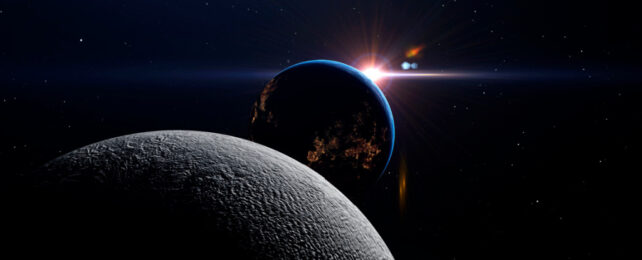Since astronauts departed the lunar surface for the last time 52 years ago, time has ticked on by. Relative to us Earthlings, the Moon has pined for our return just a little longer – by roughly 1.1 seconds.
It doesn't sound like much, and neither does the 57 millionths (0.0000575) of a second that the Moon's time stretches ahead compared to that of our home planet each day.
But that crucial result of a new study from NASA scientists could be the difference between navigation systems syncing up as the US space agency launches its long-awaited crewed missions to the Moon and beyond.
We've known about gravity's ability to slow time since Albert Einstein postulated his general theory of relativity. But the practicalities of measuring any temporal distortions that come with differences in gravity – such as the contrast between Earth's pull and the Moon's – have lagged far behind.
Only in the last decade or so have we had atomic clocks sensitive enough to detect small differences in time between two objects moving relative to each other, or under different gravitational pulls.
And with the half-century-long pause between crewed Moon landings, scientists didn't have a pressing reason to work out how those teensy time differences played out between Earth and our lunar companion. The Moon has one-sixth of Earth's gravity, but astronauts only stopped by briefly so it wasn't much of an issue.
Now scientists have a deadline: NASA is looking to return astronauts to the Moon by 2026, as part of its Artemis missions, where they will start exploring possible sites for lunar bases that one day may serve as a stepping stone to Mars.
"We're looking at a sustained presence on the Moon," NASA's Cheryl Gramling, a navigation systems engineer at the Goddard Space Flight Center in Maryland, told New Scientist's Jonathan O'Callaghan.
"Infrastructure on Earth such as GPS provides time down to the nanosecond level," Gramling continued. "If you're trying to navigate or land on the Moon, and avoid dangerous areas, then that precision matters."
Earlier this year, in April, NASA and other US agencies were tasked with working out a unified time reference system for the Moon that other space agencies could agree on.
This new finding helps in that regard, and has been in the works for some time. Slava Turyshev, a physicist at NASA's Jet Propulsion Laboratory who led the study, told O'Callaghan: "Somebody needed to sit down and work out the maths."
From Earth, it appears as if the Moon has gained 57 millionths of a second per Earth day. Turyshev and colleagues came to this number by calculating the sliding scale of time for Earth and the Moon relative to the barycentre of the Solar System. This is the Solar System's common center of mass, around which the Sun, planets and satellites orbit in a delicate balance.
Turyshev and colleagues' calculations come close to the 56.02 microseconds a different team of researchers from the US National Institute of Standards and Technology landed on in February. But tiny fractions of a second matter over such big distances, so there's still some work to do.
Neither result has been peer-reviewed, and the final definition of lunar time will need to be corroborated by a number of agencies and international bodies, such as the International Bureau of Weights and Measures and the International Astronomical Union, who plan to meet in August.
We'll also need to keep an eye on how our own planet Earth's rotation is strangely slowing down, making our days slightly longer – and how extractive human activities have altered its spin.
The research has been posted to the arXiv preprint server ahead of peer review.
